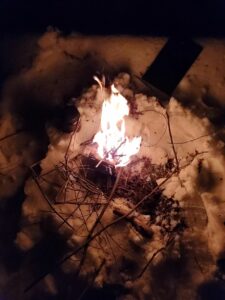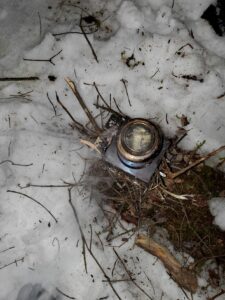There is a chance that I will be using my Firebox Stove (a bigger version of the Nano that I tried on Fire Log #4) for an extended period of time this spring. But before this test, I had yet to try it out.
Honestly speaking the main reason I decided to try it out for this particular goaround is that I was short on time. So I wanted to try to do something I had not done before that would be done and over with quickly. Since the Firebox Stove has an insert that is just for boiling water, I figured a good drill would be to see how fast it would take me to boil water using all the advantages I could ever reasonable be expected to have when camping sans a gas or alcohol stove. The plan was to have a nice short drill that confirmed how much faster things go when you have all the toys.
But as is usual when I try to go fast, it actually took longer to boil water this time then when I did the hypothermia drill.
Conditions: It was 35 degrees and wet slushy snow was everywhere. Since I was short on time, I started after dark and since it was cloudy it was very dark. Where I intended to start the fire was full of standing water under the snow so I had to move to different ground.
Test: Boil water with the Firebox Stove and the easiest possible fire starting method (semi-success).
Equipment Used: Firebox Stove, Esbit Solid Fuel Cubes, BIC Lighter, Silky Pocketboy Saw, and Stiletto Surefire flashlight.
Equipment Digression: The Firebox stove has lots of options and so is a little bit more confusing for someone like me then the simpler Nano. I don’t want to overstate that though. You can see an overview for yourself below.
Having said that, what I was trying to do was pretty simple compared to cooking a full course meal. I even set it up inside real quick to make sure that I had no issues as the picture below shows.

Narrative for the Test:
I first set up the stove inside where it was well lit to make sure I knew how it worked. In retrospect I am still confused about the bottom plate. The video calls it an ash pan but I am pretty sure the instructions call it a damper. Since I wanted to boil water as fast as possible, I left it out, but that may have been a mistake for reasons I will get to later.
Once I had an idea of how it was supposed to work, I set off into the darkness to try it out. The water was gathered from a flowing creek to insure it was as cold as possible and the clock was started as soon as I drew the water.
The area I wanted to start this fire at was the same area that I did the hypothermia drill. But there was not a single spot in that little clearing that did not have at least an inch of water under the snow. So I moved to higher ground that was more brushy. This might have been a bigger problem for a normal fire, but Firebox stove was compact enough that it was no problem to get a good spot for it.
Right near where I set up the stove was an evergreen with a bunch of thick stubs of branches that had been broken off over the years. I thought these would be good things to fill the stove with and boil the water quickly without having to look around for fuel. So I cut a few of them off with my saw.
The first thing I had noticed was that they were a lot softer and wetter on the outside then I would have liked. But it looked like they had really good resin on the inside. I thought about looking around for better wood (which as it turns out would have been easy to get) but figured the resin and the Esbit tabs would make up for that. That was a call that was technically correct in the sense that it did work but the wrong call to make in terms of speed.
I ran into my first problem with these short stubs when I went to put them in the fire box standing up and found they were too long to get the water boil plate in. I had anticipated that I might need to trim them down, but I found that cutting wood that was already so short with a saw one handed was a trick to do safely. I decided to just put them in the fire box as they were (after cutting one down to size) on the theory that they would burn down quickly and then I would put the plate for boiling water in.
The second problem I ran into was that the first Esbit fuel tab I tried to use broke into a bunch of little pieces. I am not sure if that happened in my pocket or it was caused by my less then elegant method of getting it out of its packaging. Either way, it made the Esbit lot harder to use then I was anticipating. I lit the biggest chunk and tried to pour the pieces into the stove but nothing went where I wanted it to and the fire was mostly confined to one corner of the stove. If I had had the bottom plate in, this might have gone better as I suspect that a lot of the first tab fell out of holes on the bottom and did not do anything for me.
I tried to coax the fire out of the corner by finding actual dry twigs and feeding them in. I had some success doing this but the wet outer wood on my big chunks of wood and the fact that they were set up for the fire starter to go in the center of the stove made this a very slow process. When I finally realized how much time salvaging this situation was taking, I got out a second Esbit fuel tab, lit it, and dropped it in the center where I intended the first one to go.
This got things going pretty well. I am sure it would have been faster if the wood had been truly dry but in fairly short order I had impressively high flames coming out of the stove as you can see from the picture below.

I attribute this roaring fire inferno in part the fire box design and in part to all the resin finally being released from the wood. But even with this fire, it still took some time for the wood to burn down to point where I could install the plate that would hold the water bottle.
It was then that I discovered that I had forgotten to bring the leather gloves. When you are working with metal fire boxes that have an active fire in them, leather gloves makes everything easier. The lack of those gloves made putting in the plate a much more delicate and time consuming affair then it would have otherwise been. I still got it done without burning myself though.
After that, the water boiled impressively fast. I think it was faster than it would have boiled on the gas stove in the kitchen on the largest burner. But there was one last mistake that I had made that made itself known when the water began to boil.
I had overfilled my water bottle in the creek and had not really thought anything about it. But as soon as the water began to boil it over flowed and basically put out the fire. Since the entire point was to boil the water and the water was certainly still in a rolling boil, it did not matter much. But if I had intended to do more with the stove (like cook a meal) it would have been very aggravating.
You can see what was left of my poor fire in the picture below.

Since the water was boiling, I stopped the clock. Putting out what was left of the fire was easy. I tipped over the stove and put snow over the coals that were left. You are not supposed to dump water over these stoves as it damages the metal over time. But they cool fast and clean up after a fire is easier with one of these stoves then if you make a normal campfire.
Total Time Of Test: 64 minutes (by comparison, the similar test I did without anything fancy for the hypothermia drill took 45 minutes).
Lessons Learned:
1. Wood stoves take some thought and practice before they save you anytime. The time this took was entirely due to my failures but you need to put more thought into using one of these
things then you do into making a simple fire.
2. Esbit fuel tabs need to be protected from being crushed.
3. Don’t take short cuts when trying to start a fire (I already know this but I have to keep learning it).
4. Fireboxes burn very efficiently which means the fire is small. If something boils over, it is likely to put the entire fire out.
5. Don’t forget the leather gloves if you plan on doing a lot of cooking with a metal wood stove.
